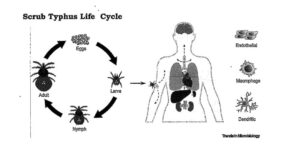Scrub typhus — also known as bush typhus — is caused by a bacterium called Orientia tsutsugamushi, which is transmitted to humans through the bite of infected chiggers, a type of mite. It could be fatal, if not treated.
Published Jan 03, 2025 | 8:00 AM ⚊ Updated Jan 03, 2025 | 8:00 AM

Eschar on the left arm of a patient diagnosed with Scrub Typhus. (Creative Commons)
Tamil Nadu’s Health Department has issued an advisory regarding an outbreak of scrub typhus, a rickettsial disease that is primarily transmitted through insect bites.
The disease, on an uptick in the state, is characterised by fever, body aches, headache, and distinctive black rash-like lesions at the bite site.
Affected regions include Chennai, Tiruvallur, Kanchipuram, Chengalpattu, Ranipet, Vellore, and Tirupathur, with additional cases reported in several southern districts.
Scrub typhus — also known as bush typhus — is caused by a bacterium called Orientia tsutsugamushi (formerly Rickettsia tsutsugamushi), which is transmitted to humans through the bite of infected chiggers, a type of mite.
This zoonotic disease affects people, particularly agricultural workers, living in areas with dense vegetation, those residing near bushes or forests, and campers and trekkers. While humans are accidental hosts, the disease’s transmission cycle involves rodents and mites.
Symptoms of scrub typhus typically appear within 1-2 weeks after the mite bite.

Lifecycle of scrub typhus.
Initial symptoms resemble those of the flu, high fever, headache, body pain, and rash. One of the hallmark signs of scrub typhus is the appearance of an “eschar,” a dark, necrotic ulcer that forms at the site of the bite.
If left untreated, the infection can lead to severe complications, including heart, lung, kidney, and neurological issues, potentially causing death.
Scrub typhus is prevalent in the southern parts of Tamil Nadu, including areas around the Eastern Ghats, Western Ghats, and the Deccan Plateau.
The disease is also commonly reported in agricultural regions, where people come into close contact with the environment that hosts infected mites. Groups at risk include:
Timely diagnosis is crucial for effective management of scrub typhus. The disease can be identified through several laboratory methods, including:
Once diagnosed, the treatment for scrub typhus varies, depending on the age and health condition of the patient. Standard medications include:
In cases of severe illness or complications such as cardiac, pulmonary, renal, or neurological issues, patients may need hospitalisation and intravenous antibiotics, such as doxycycline or azithromycin, before switching to oral therapy.
The health department outlined several preventive measures to curb the spread of scrub typhus:
The rise in scrub typhus cases has prompted the health department to heighten vigilance. District Health Officers and City Health Officers have been instructed to monitor the situation closely, ensure timely diagnosis and treatment, and carry out preventive measures to control the disease’s spread.
Public health campaigns, along with targeted interventions in rural and peri-urban areas, are expected to play a crucial role in mitigating the risk of further outbreaks.
As scrub typhus continues to affect various districts, the importance of rapid diagnosis, effective treatment, and preventive measures cannot be overstated.
Residents in high-risk areas have been urged to take necessary precautions and seek immediate medical attention if symptoms of scrub typhus are detected.
(Edited by Majnu Babu).
